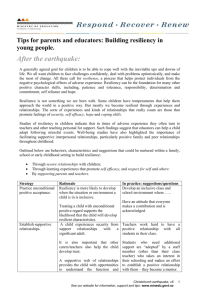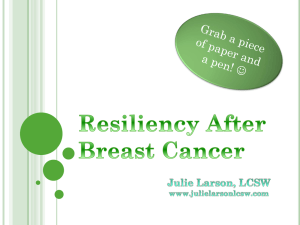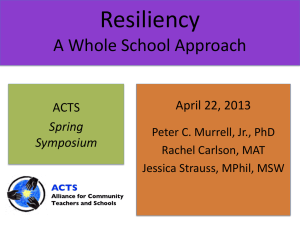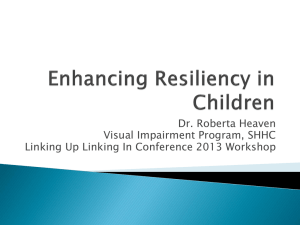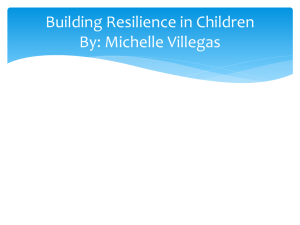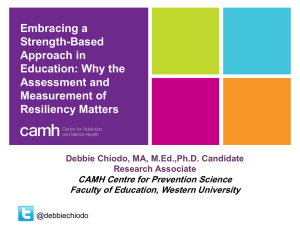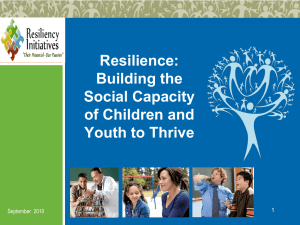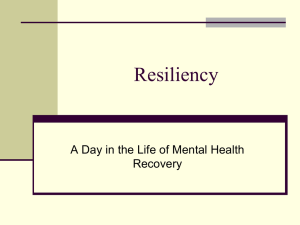Resiliency: An Essential Leadership Skill
advertisement
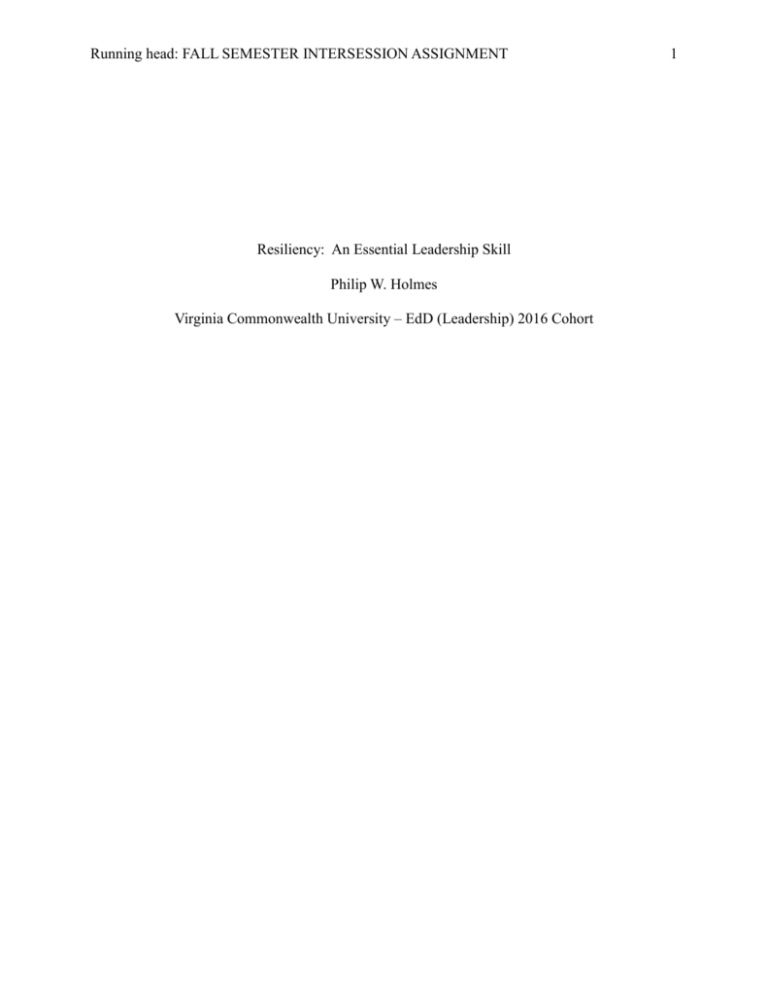
Running head: FALL SEMESTER INTERSESSION ASSIGNMENT Resiliency: An Essential Leadership Skill Philip W. Holmes Virginia Commonwealth University – EdD (Leadership) 2016 Cohort 1 FALL SEMESTER INTERSESSION ASSIGNMENT 2 Resiliency: An Essential Leadership Skill As the author prepares to enter the third semester of his doctoral program (and thus approaches the end of his first full year of doctoral study), it is appropriate to review his progress and to draw preliminary conclusions about the leadership skills that are essential for leaders in general, and the leadership skills that are essential for the author in particular. These conclusions will be based primarily on the author’s experience over the past two semesters and on a focused literature review. Reflection Several months ago, I stepped for the first time into a doctoral-level classroom. After many years of wanting to begin doctoral work, I was finally able to align personal, professional, and family resources and begin work on my doctorate in leadership at VCU. I walked into that classroom on that first day with a head full of an odd mixture of information about doctoral study, pulled from my research, my imagination, general lore about doctoral study, and the wisdom and warnings from friends and colleagues who had attained that level of academic success. I also walked into that classroom with a practitioner’s view of the study of leadership, over two decades of experience with helping others learn how to lead, and extensive feedback from managers and peers on my own leadership skills. Some of the ideas about leadership that were in my head that first day have been retained, and others have been jettisoned. In the petty maelstrom of the last several months, I have learned a great deal about leadership because of what I have read, digested, analyzed, and presented, and also because of what I have experienced. I have balanced intellectual understanding with personal, visceral understanding (that is, from tough lessons and hard knocks). I have seen conclusions jump out at me from the pages of my textbooks, and I have grudgingly accepted FALL SEMESTER INTERSESSION ASSIGNMENT 3 conclusions that arose painfully from the uneven personal experiences of my first year of doctoral work. I entered this program thinking that successful leaders draw from the standard well of leadership skills – the skills that are laid out in the Likert scale of our 360-degree feedback report: setting direction, teamwork, sensitivity, judgment, results orientation, organizational ability, oral communication, written communication, developing others, and understanding one’s own strengths and weaknesses. To be fair, these are important leadership skills, and if the leaders that I work with had these in abundance, my job would be easier. If I had these in abundance, I would likely not need this doctorate. But after studying my 360-degree feedback results, reflecting on the variegated personalities, skills, and preferences of my fellow cohort members, and considering the waves of organizational, industrial, cultural, managerial, and personal change that have at some times made my individual skills in great demand at my company, and at other times have made them worthy of disregard, I am no longer sure that such a list is enough. I wonder whether it will ever be appropriate or sensible to create a list of essential leadership traits. Such lists are just snapshots in the fast-forward film of American leadership. I have concluded that in this fast-forward film of American leadership, it is impossible to avoid situations where one’s best will not be good enough. Despite one’s best efforts, there will always come a day when the world will require A, and one will only have B or C in one’s quiver. There will come a day when the suite of skills that one has always wielded successfully will not be sufficient. There will come a day when – despite one’s best efforts – organizational, industrial, cultural, managerial, and personal changes will conspire, and the threat of failure will rise darkly over one’s head. On that day, the leader will need to change, and the ability to change FALL SEMESTER INTERSESSION ASSIGNMENT 4 will be more important than the change itself. On that day, resiliency will be the most essential leadership characteristic. The most effective leaders are those leaders who move forward not just when circumstances fit their personalities, but when circumstances do not. The most effective leaders are those leaders who can see the goal ahead even when the noise and smoke of our chaotic lives make that goal difficult to discern. The most effective leaders are those leaders who absorb the possibility or actuality of failure, and change – and find in that experience of change something new, good, and worthwhile to grasp and absorb. I have not always been resilient – there have been several times over the past several months when I was definitely not resilient – and so I have focused on resiliency as the most essential (and often overlooked) leadership skill. Literature Review - Resiliency Definition of Resiliency Researchers generally agree that resiliency is the ability to cope with one or more difficult and challenging stressors (Casey, 2011; Garcia-Dia, DiNapoli, Garcia-Ona, Jakubowski, & O’Flaherty, 2013). Christman & McClellan (2008) summarized resiliency as “an adaptive and coping trait that forms and hones positive character skills, such as patience, tolerance, responsibility, compassion, determination, and risk taking” (p. 7). Christman & McClellan (2008) further noted that many of these skills “seem to run counter to the socially constructed concept of masculine leadership” (p. 7). In his review of the US Army’s recent Comprehensive Soldier Fitness program (designed to improve resilience throughout the Army), Casey (2011) noted that the “prevailing view among many within our ranks is that having problems with stress [i.e., not being resilient]…is not only inconsistent with being a warrior but also a sign of weakness” (p. 2). No other research in the review explicitly tied resiliency with either feminine FALL SEMESTER INTERSESSION ASSIGNMENT 5 or masculine traits; however, it appears to be an interesting and potentially fruitful direction for future research to follow. Essential to the concept of resilience is the presence or likelihood of adversity or a serious threat, and also the adaptive response which that adversity or threat provokes (Christman & McClellan, 2008; Garcia-Dia, et al., 2013; Gu & Day, 2013; Norman, Luthans, & Luthans, 2005). Individuals who respond in a resilient manner to a threat or a challenge are supposed by definition to be improved by the act of being resilient, at least insofar as their ability to be resilient in the future is concerned (Harland, Harrison, Jones, & Reiter-Palmon, 2005; Christman & McClellan, 2008; Yonezawa, Jones, & Singer, 2011). While early research on resiliency focused on certain key traits that were supposed to exist in resilient individuals, Yonezawa, et al. (2011) noted that current research focuses on the “adaptive processes” that help people work through difficult situations and become resilient (p. 916). Drath (2001) posited three central tasks of leadership – setting direction, creating and maintaining commitment, and facing adaptive challenge. The latter task is specifically connected to the concept of resiliency, because it includes the notion of adaptation (the requirement that the individual must change in response to an adaptive or radical challenge). For Drath, an adaptive challenge is one that “causes confusion,” because it represents a challenge that has not been encountered before; more to the point, an adaptive challenge is one that forces the individual or the group to change in order to respond to it, and thus it requires the exercise of resiliency (p. 21). While resiliency is partly innate (that is, it is based in part on numerous individual traits, the exact listing of which tends to vary from researcher to researcher), it is also partly under the control of individuals – either by virtue of a conscious decision to hone or learn key coping FALL SEMESTER INTERSESSION ASSIGNMENT 6 skills, to seek or nurture family and social supports, or to take advantage of assistance offered by one’s organization or community (Christman & McClellan, 2008; Garcia-Dia, et al., 2013; Gu & Day, 2013; Harland, et al., 2005). Garcia-Dia, et al. noted that a “combination of psychosocial elements and biological predispositions… help to define what is now known as resilience,” and that a mixture of “external and internal factors… cultivate resilience” (p. 265). Gu and Day (2013) further suggested that among the internal and external factors that collude to create a resilient response to a threat or adversity, more personal and idiosyncratic aspects of one’s emotional and psychological makeup must be included. In their study of resilient teachers in Great Britain (2013), they concluded that “resilience in teachers is the capacity to manage the unavoidable uncertainties inherent in the realities of teaching,” and that resilience “is driven by teachers’ educational purposes and moral values” (p. 39). Yonezawa, et al (2011) echoed this conclusion, and included morality among the characteristics found in resilient teachers. Smith & Roysircar (2010) also included “communal or collective values” among the factors related to resiliency found in African-American professionals (specifically past presidents of the Association for Multicultural Counseling and Development), as well as mentors (p. 248). It is important to note that peer-reviewed articles on resiliency and leadership efficacy are relatively uncommon. Harland, et al. (2005) directly stated that there were not able to find any “empirical research directly linking resilience and leadership,” though numerous authors have “theorized a link between leadership and resilience” (p. 4). Norman, et al. (2005) noted increased interest in the connection between resiliency and leadership, which is spilling over into the corporate world, with companies like Hewlett-Packard beginning to train their employees to be more resilient. Christman and McClellan (2008), Gu and Day (2013), and Yonezawa, et al. FALL SEMESTER INTERSESSION ASSIGNMENT 7 (2011) all studied the impact of resilience on teacher effectiveness in particular, and for our purposes here there is no reason to assume that the lessons learned by resilient teachers (who lead in their classrooms) are not applicable to the principals who manage them or to managers and leaders in other industries and fields. In the last decade, research in the fields of psychology and human resource development has begun to add interesting points of view to the study of resiliency. Norman, et al. (2005) noted the launch in 1998 of the “positive psychology movement” by Martin Seligman (at that time, President of the American Psychological Association), dedicated to giving “attention to what is right with people instead of concentrating on what was wrong with people” (p. 57). Researchers in allied fields quickly moved to find practical applications of positive psychology. For example, Fred Luthans in 2002 posited a new field of inquiry called Positive Organizational Behavior, or POB, focusing “on states that can be developed and managed for performance improvement of individuals and organizations” (Norman, et al., 2005, p. 57). Resiliency was one of those states of focus; when combined with hope, optimism, and efficacy, it formed “what Luthans and colleagues call positive psychological capital, or simply PsyCap” (Norman, et al., 2005, p. 57). The research into positive psychological capital and its potential impact on individuals and organizations across all fields and industries is in its early stages; however, preliminary findings suggest that hopeful and resilient leaders can have a kind of “contagion effect” with their employees, and that “employees perceive the leader’s hope and take on this hope state,” which “affects their resiliency and the overall organization’s resiliency” (Norman, et al., 2005, p. 60). Norman, et al. (2005) concluded that it will be important “to study these POB states of hope FALL SEMESTER INTERSESSION ASSIGNMENT 8 and resiliency and find ways to systematically develop them within individuals and overall organizations” (p. 62). Best Practices While the earliest research on resiliency suggested that effective resilient responses among people were uncommon, more recent research indicated that the opposite is more likely, and that people who exhibit effective resilient responses to adversity and other challenges are not at all exceptional (Norman, et al., 2005). But, despite the fact that experiences of resiliency are likely more common than earlier research suggested (which therefore also suggests the existence of far more potential research subjects than earlier researchers had anticipated), research on actual best practices related to resiliency are not legion, and when found are far more general than specific. As noted in the previous section, Norman et al. (2005) concluded that further research to “find ways to systematically develop [hope and resiliency] within individuals and organizations” is crucial (p. 62); however, at this point, research has focused on proving the importance of hope and resiliency in the workplace, and not on exactly how to make people and organizations more hopeful and resilient. Nearly all research in this review has indicated that inherent character traits are essential to resiliency; however, the actual list of essential traits has varied from study to study. As noted above, Christman and McClellan (2008) indicated that “positive character skills, such as patience, tolerance, responsibility, compassion, determination, and risk taking” are essential to resiliency, (p. 7) and for our purposes here, the key is not so much the individual skills noted, but rather the overarching category of “positive character skills.” FALL SEMESTER INTERSESSION ASSIGNMENT 9 In addition to these internal factors (these positive character skills), the successfully resilient individual (leader) must also rely on external supports (Christman & McClellan, 2008; Garcia-Dia, et al., 2013; Gu & Day, 2013; Harland, et al., 2005). Much work remains, however, to determine which external supports are most helpful, and how their influence is best applied. Strengths and Limitations of Resiliency The strengths or benefits of resiliency are clear, given its definition: that is, the ability to respond effectively to a real or perceived threat or episode of adversity, and to emerge from that response with a greater ability to weather future threats or periods of adversity. Simply put, the research uncovered in this review indicated that resilient individuals have positive impacts on their organizations, and after they exhibit the ability to be resilient, they are stronger and more effective in their personal and professional lives (Casey, 2011; Christman & McClellan, 2008; Garcia-Dia, et al., 2013; Gu & Day, 2013; Harland, et al., 2005; Norman, Luthans, & Luthans, 2005; Smith & Roysircar, 2010; Yonezawa, et al., 2011). The literature does not address, however, the limitations of resiliency. The first response to the suggestion that there might be limitations to the ability to respond effectively to threats or periods of adversity would likely be skepticism. It is difficult to imagine rational benefits for decreasing any individual’s or leader’s ability to weather threats or adversity, and no research advocating that point of view was uncovered during this review. Yet, the definition of resiliency presupposes the existence of sub-optimum conditions. To be resilient, one must be faced with threats or adversity, and in an optimum environment or organization, such threats or episodes of adversity would be limited or curtailed. In any field or industry, conditions will vary. Individuals or leaders will sometimes encounter workplace conditions that are amenable to their happiness and growth, and sometimes FALL SEMESTER INTERSESSION ASSIGNMENT 10 they will encounter workplace conditions that are in opposition to their happiness and growth. This variation is to be expected, and is usually the result of changing circumstances that are outside of their control (different jobs, different managers, different responsibilities). But, leaders will also sometimes encounter conditions that are in opposition to their happiness and growth because of flaws, weaknesses, or problems within their organizations. At these times, leaders have a special responsibility to push back against their organizations, because the people who report to those leaders rely on them to do so. In these cases, resilient leaders might actually be avoiding their responsibility to give feedback to their senior leadership about conditions that are not episodic (and therefore expected as a matter of course), but are actually the result of poor decisions made by those senior leaders. Analysis Gu and Day (2013) noted that “the widely used definition of resilience as the capacity to ‘bounce back’ in adverse circumstances is inadequate to describe the nature of resilience in teachers,” because “it fails to reveal and reflect the uncertain and unpredictable circumstances and scenarios which form the main feature of teachers’ everyday lives” (p. 39). For these researchers, the older definitions of resiliency – which rested on the assumption of intermittent or only occasional threats or periods of adversity – did not correlate with the more chronic pressures faced by contemporary teachers. Gu and Day (2013) further noted that “uncertain and unpredictable circumstances and scenarios” are no longer intermittent or episodic, and are “an inherent part of the nature of teaching and present a constant intellectual and emotional challenge to teach to their best” (p. 39). This research suggests that the ability to be resilient is no longer an occasional benefit for teachers, but rather an expected or baseline skill. FALL SEMESTER INTERSESSION ASSIGNMENT 11 In his exploration of the need for the US Army to become more resilient, Casey (2011) noted that “persistent conflict” is the new normal situation for those dedicated to the defense of the United States, and added that “protracted confrontation among state, non-state, and individual actors who are increasingly willing to use violence to accomplish their political and ideological objectives” is the hallmark of the current era, and “we in the Army cannot determine when this era of persistent conflict is going to end” (p. 1). Norman et al. (2005) noted the possibility of a “resiliency gap” in American business, resulting from the fact that “as the world around us changes more quickly than ever before, employees, leaders, and overall organizations are struggling to keep up and manage their resilience” (p. 55). This conclusion meshes with the conclusion raised by Bolman and Deal (2008), who noted that “the world of most managers and administrators is a world of messes: complexity, ambiguity, value dilemmas, political pressures, and multiple constituencies” (p. 41). The findings of these researchers constitute a clear call for greater appreciation of the characteristic or trait of resiliency, and for greater study of how that trait or characteristic can be uncovered, honed, or improved. All of these researchers contend that the current environment in education and in business is one in which threat and adversity are not episodic, or intermittent, or unusual; rather, threats and adversity are normal, expected, and unlikely to fade away. In such an environment, the ability to be resilient is not a luxury for any responsible leader. Harland et al. (2005), in their study of leadership behaviors and subordinate resilience, recount the history of Ernest Shackelton, a British explorer who was trapped along with his crew in the Antarctic between 1914 and 1916 on their ship Endurance, some twelve hundred miles from civilization (p. 2). During the early years of the twentieth century, many expeditions FALL SEMESTER INTERSESSION ASSIGNMENT 12 explored both the north and the south poles. While nearly every other polar expedition of that exuberant (if somewhat ill-prepared) exploratory time period was marred by loss of life, every single member of the crew of the Endurance survived. Harland et al. (2005) attribute this remarkable accomplishment “to the leadership of Ernest Shackelford, whose leadership behaviors fueled the resilience of his stranded crew over and over again during their almost twoyear ordeal” (p. 2). The average manager or leader does not face the life or death struggles of an Ernest Shackelton. But, as Harland et al. (2005) noted, “all leaders are likely to face situations where employees experience setbacks and challenges,” and everyone “has an Antarctic” (p. 2). They concluded that how “people respond to workplace setbacks is a function of resilience,” and asked, “do leaders make a difference in helping employees become more resilient in the face of their own ‘Antarctics’?” (p. 2). The author believes strongly that leaders can make that difference for their employees, as long as they focus first on their own ability to be resilient. Conclusion The members of this cohort were surprised to learn that they had an intersession assignment, as it was not in the syllabus of either of their courses in the fall of 2013. The fall semester was our first full semester of doctoral study, and most of us approached the end of the year as exhausted as we were fulfilled. The realization that our holiday break would have another research paper hanging over it was not a happy one. I cannot deny that I have wrestled with this paper, in large part because of a deep personal sense that its assignment was unnecessary and to some extent reflective of academic pettiness. At the same time, the assignment has forced me to examine my personal, vocational, and academic responsibilities more closely than I had ever expected, and through clenched teeth, I FALL SEMESTER INTERSESSION ASSIGNMENT must admit that I am grateful for this opportunity to approach, apprehend, and value my own ability to be resilient. 13 FALL SEMESTER INTERSESSION ASSIGNMENT 14 References Bolman, L. G., & Deal, T. E. (2008). Reframing organizations: Artistry, choice, and leadership. San Francisco, CA: Jossey-Bass. Casey, G.W., Jr. (2011). Comprehensive soldier fitness: A vision for psychological resilience in the U.S. Army. American Psychologist, 66, 1-3. doi: 10.1037/a0021930 Christman, D., & McClellan, R. (2008). "Living on barbed wire": Resilient women administrators in educational leadership programs. Educational Administration Quarterly, 44, 3-29. doi: 10.1177/0013161X07309744 Drath, W. (2001). The deep blue sea: Rethinking the source of leadership. San Francisco, CA: Jossey-Bass. Garcia-Dia, M.J., DiNapoli, J.M., Garcia-Ona, L., Jakubowski, R., & O'Flaherty, D. (2013). Concept analysis: Resilience. Archives of Psychiatric Nursing, 27, 264-270. Gu, Q., & Day, C. (2013). Challenges to teacher resilience: Conditions count. British Educational Research Journal, 39, 22-44. Harland, L., Harrison, W., Jones, J. R., & Reiter-Palmon, R. (2005). Leadership behaviors and subordinate resilience. Journal of Leadership and Organizational Studies, 11, 2-14. Norman, S., Luthans, B., & Luthans, K. (2005). The proposed contagion effect of hopeful leaders on the resiliency of employees and organizations. Journal of Leadership and Organizational Studies, 12, 55-64. Smith, M. L., & Roysircar, G. (2010). African American male leaders in counseling: Interviews with five AMCD past presidents. Journal of Multicultural Counseling and Development, 38, 242-255. FALL SEMESTER INTERSESSION ASSIGNMENT Yonezawa, S., Jones, M., & Singer, N. R. (2011). Teacher resilience in urban schools: The importance of technical knowledge, professional community, and leadership opportunities. Urban Education, 46, 913-931. 15
